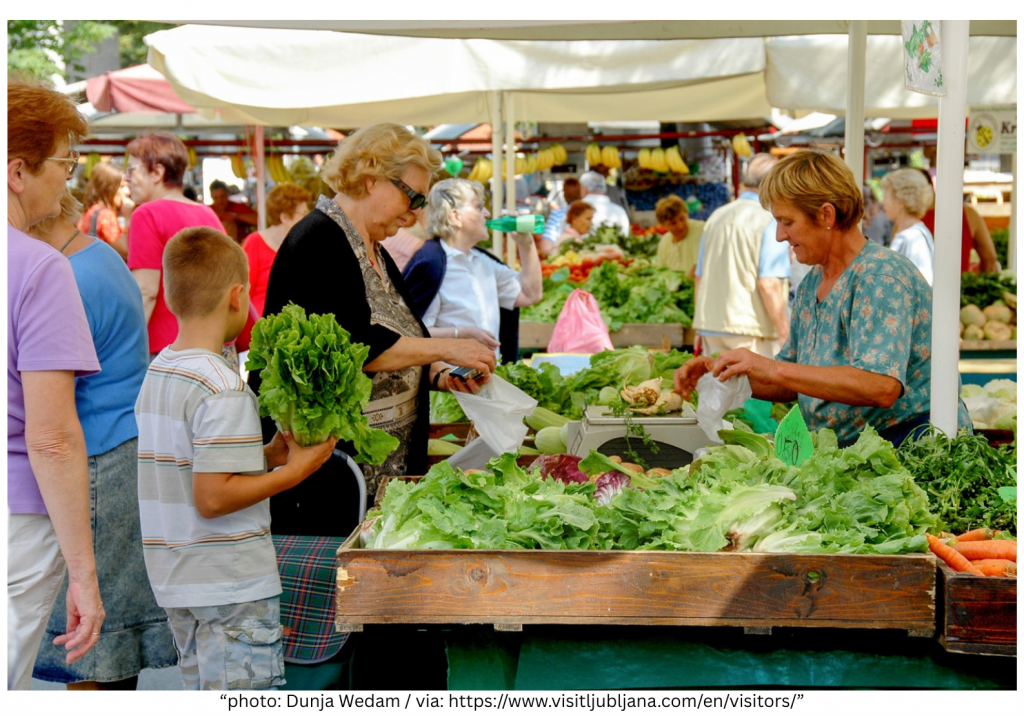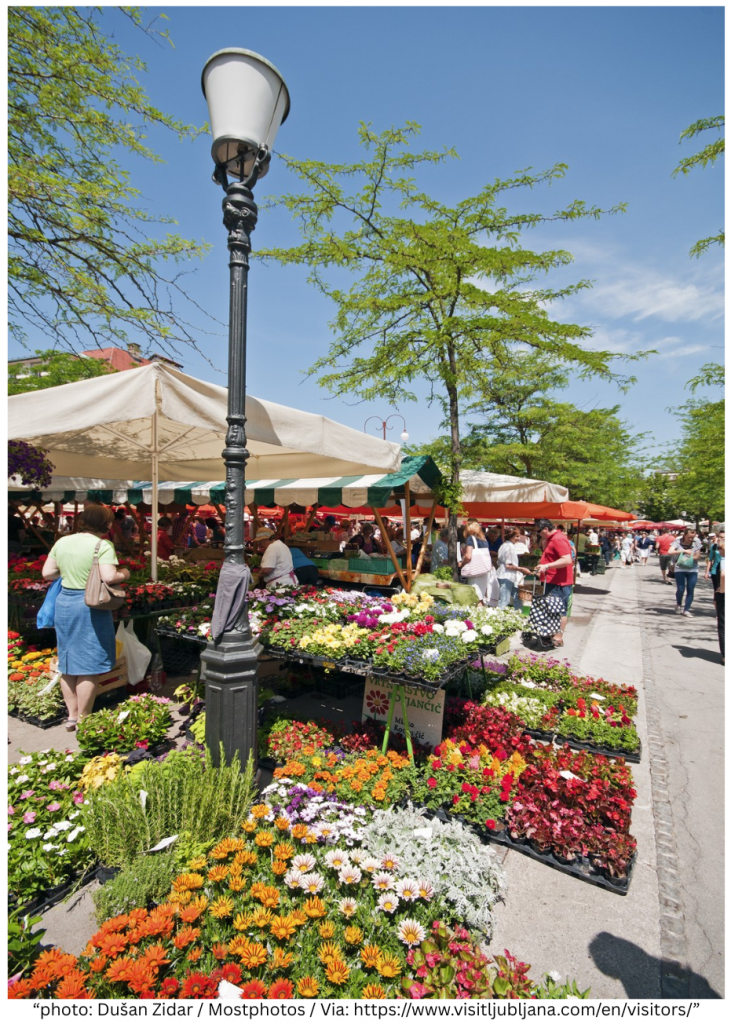
Growing up in a small, green country, I didn’t go looking for lessons in sustainability. It was always in front of me as a part of everyday life. 🍃 We can often overlook what’s right in front of us until we experience life elsewhere.
We ate what was in season, and we never let food go to waste. Food in Slovenia is not just about eating; it’s about respect and resourcefulness.
Markets overflow with whatever the season has to offer, and traditional dishes are created to waste as little as possible.
What does eating seasonally mean?
Eating seasonally just means enjoying fruits, veggies, and other foods when they’re naturally in season where you live. It’s a simple way to support local farmers, eat healthier, and do a little good for the planet at the same time.
There’s a big difference between seasonal and nonseasonal produce. Take tomatoes, for example — they naturally grow from late spring to early fall, yet you’ll still see them looking fresh and red in the supermarket in the middle of winter. How? Often, they’re picked before they’re ripe and sprayed with ethylene gas to make them look ready to eat. On top of that, many have traveled long distances just to reach your plate. That’s how we’re able to buy them year-round, but it also means a bigger environmental footprint:
❗These out-of-season practices are common, and each comes with its own environmental costs:
☁︎ Imported fruit
- Stores bring in fruits from other countries where they are in season. For example, strawberries from Spain in winter — more CO₂ from trucks, planes, or ships.
☁︎ Greenhouses
- Some fruits are grown out of season in controlled environments, using extra heat, light, and water — plus more fertilizers or pesticides.
☁︎ Freezing or storage
- Fruits picked in season can be frozen, canned, or stored in cold conditions for months, so they’re available later, but at the cost of additional energy and packaging.
☁︎ Food loss during transport
- Shipping fresh produce long distances increases spoilage, meaning more food waste before the produce even reaches store shelves.
❗Beyond tradition and environmental impact, eating seasonally can also benefit your health in surprising ways:
💚 Higher nutrient content
- Seasonal fruits and vegetables are fresher. They haven’t spent weeks traveling or sitting in storage, so you get more nutrients per bite.
💚 Better flavor = less need for additives
- Seasonal produce is riper and tastier, so you don’t need to add as much sugar, salt, or sauces to make it enjoyable.
- Riper fruits are naturally sweeter, which can help reduce cravings for processed sweets.
💚 Supports digestive health
Seasonal foods often align with what your body needs at that time of year:
- In spring, leafy greens and sprouts are abundant—light, fresh foods that help cleanse and refresh your system after winter.
- In fall and winter, root vegetables and squashes are denser and warming, which can support digestion and energy levels.
💚 Fewer preservatives and chemicals
- Out-of-season produce often requires long storage, refrigeration, and chemical treatments (like ethylene gas or wax coatings) to stay fresh.
- Choosing seasonal produce means fewer additives and a more natural, fresher taste.
💚 Supports a balanced diet
- Seasonal eating naturally rotates your diet throughout the year. Different fruits and vegetables contain different vitamins and minerals —rotating seasonally helps you cover more nutritional bases.
💚 Potential mental health benefits
- Eating seasonal, local foods can increase connection to nature and your local community, which studies suggest can improve mood and reduce stress.
- Cooking with seasonal ingredients often encourages more home-cooked meals, which are linked to healthier eating habits and overall well-being.
🌿Eating seasonal food as a lifestyle in Slovenia:
A lot of families in Slovenia are lucky to have gardens right behind their homes, full of fresh fruits and vegetables. 🍅 In urban areas, it’s a bit trickier, but Slovenians always find a way. Give us a two-square-meter balcony, and we’ll manage to grow fresh herbs, small fruits, and even a few vegetable plants. 🪴 But with each new generation, fewer young people are carrying on the tradition of gardening. Still, the influence of our mothers and grandmothers remains strong. Growing up, I remember my mom refusing to buy tomatoes or fresh fruit from the supermarket in winter. Instead, we ate what was in season — either from the local farmers’ market or from what we’d grown and saved ourselves.
Each time of year had its own flavors, traditions, and rituals — many of which are still part of Slovenian culture today.
🌱 Spring
- Collecting wild garlic (čemaž) in forests to make spreads, soups, or pesto.
- Using dandelion leaves (regrat) for fresh salads, often with eggs and potatoes.
- Eating the first strawberries, cherries, and asparagus — a sign that warm days have arrived.
☀️ Summer
- Fresh tomatoes, cucumbers, and peppers straight from the garden, often turned into simple salads.
- Making homemade jams from apricots, plums, or berries to store for winter.
- Gathering around for grilled vegetables and corn on the cob.
🍂 Autumn
- Chestnut season (grilled or boiled) — a true Slovenian favorite.
- Grape harvest (trgatev) with family and neighbors, ending in a feast.
- Making sauerkraut and pickled turnips (kislo zelje, repa) to last through winter.
- Walnuts and apples are showing up in desserts like potica.
❄️ Winter
- Sauerkraut and turnips as staples in stews.
- Homegrown potatoes stored from the autumn harvest.
- Dried beans, lentils, and other preserved goods make up traditional winter meals.
- Festive foods like potica (walnut roll) at Christmas and krofi (doughnuts) during Carnival.
These are traditions I really miss, and while city life makes them harder to follow, it’s not impossible — it just takes a bit of awareness and planning.
💡Practical ways to start eating more seasonally:

💡Farmers’ Markets
⤷ Visiting local farmers’ markets whenever possible — they sell what’s currently in season because small farms don’t usually import out-of-season produce.
💡Grocery Store Tips
⤷ Even in supermarkets, look for signs that say “local” or “grown nearby.” These are more likely to be seasonal.
⤷ Pay attention to price drops — when strawberries are cheap and abundant, they’re probably in season.
💡Seasonal Guides
⤷ Print or save a seasonal produce chart for your region
⤷ Apps like Seasonal Food Guide can help you see what’s fresh each month, making it easier to plan meals and shop seasonally.
💡Preserve for the off-season
⤷ Freeze, can, or dry produce when it’s abundant. That way, you still enjoy seasonal food later without relying on imports.
💡Try a “seasonal challenge”
⤷ For one month, commit to cooking mostly with foods in season locally. It can be fun and eye-opening.
💡Start small
⤷ Choose just one fruit and one vegetable to always buy seasonally. Over time, expand this habit
🌿 Growing up in Slovenia taught me that eating with the seasons is more than just healthy— it reminds me that food tastes best when it’s fresh, local, and in rhythm with nature.
💌 Today’s note: Eating seasonally doesn’t have to mean giving up your favorite foods—it’s about reconnecting with nature, respecting resources, and enjoying the best flavors each season has to offer. Even small changes can make a difference for your health and the planet.
⤷ The farmers’ markets in Slovenia, like the one pictured in Ljubljana, are still at the heart of seasonal eating today. You can learn more about the Ljubljana Central Market here.


